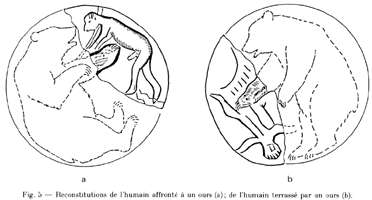Discs from the stone age
There are many examples of discs with central holes from various (mostly Magdalenian) sites in Europe. The most famous are those made of bone or ivory which bear carvings of various kinds, and are art objects in their own right.
Various theories have been put forward as to their use, including clothing decoration and large buttons. These are unlikely primary uses, since all have just one, central hole. If they were meant to be sewn to clothing they would have two or more holes to facilitate attachment, or would have the hole close to one edge if they were meant to be worn as a pendant.
As my colleague Ann Dayton first pointed out, (pers. comm. December 2014 ) their most likely use is as the weight (normally called a whorl) for a drop spindle, in the spinning of fibres into yarn.
This is borne out by the fact that the overwhelming majority have a central hole, all of similar dimensions, 2 to 4 mm, and by the fact that many are not decorated in any meaningful or artistic way, and are also made of other materials (sandstone, slate) than bone.
The most likely use for these objects is as spindle whorls.

Rondelle in sandstone, perforated and engraved, from Isturitz. This piece has had a great deal of care lavished on it to make it symmetrical, and to have a circular ornamentation consistent with its use as the whorl for a drop spindle, used for spinning yarn. A thin wooden, bone, or ivory rod would have been pushed through the hole in order for it to be used as a drop spindle.
Photo: Don Hitchcock 2014
Source: Original, Musée d'Archeologie Nationale et Domaine, St-Germain-en-Laye
Gönnersdorf Rondelles
A very important site for rondelles or discs of this type is Gönnersdorf in Germany. Here, more than 400 rondelles or parts thereof were found, almost all made of slate. Few were decorated in any way, most were obviously used for a particular purpose.
During the excavations in 1968, and 1970 to 1974, 382 Rondelles or parts of rondelles which could be identified with respect to diameter were found in Gönnersdorf. With two exceptions, they are made of slate. The other two pieces are made of antler and mammoth ivory; both are intact, but it seems that they were undecorated, although the surface was heavily corroded.
Text above translated and adapted from: Bosinski (1977)
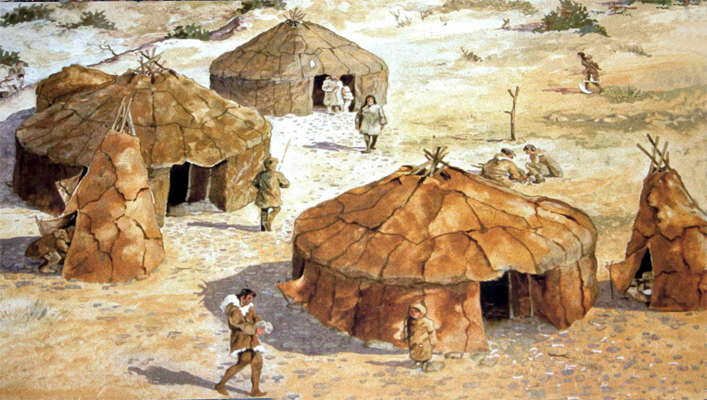
Image of the Magdalenian settlement in Gönnersdorf, 12 500 BP, RGZM special exhibition in Mainz 1975.
Traces of two small round tents, and three large, fur-covered dwellings, with a broad oval shape, similar to a yurt, were revealed with a diameter of 6 to 10 metres. They were coloured red on the inside and outside, and the floors were paved with slate.
The settlement was systematically excavated over an area of 650 square metres, and bones were found of mammoth, horse, bison, aurochs, reindeer, deer and arctic fox, as well as birds.
Photo: http://www.landschaftsmuseum.de/Bilder/Rekonstr_Rundzelt-2.jpg
Text: http://www.landschaftsmuseum.de/Seiten/Lexikon/Kunst-Goenn.htm
The pieces found indicated that first the pieces were made as round discs, and then they were pierced at the centre. There were groups of well made discs with no central hole made, as though it was part of a production process. The holes were made from each side, since they were biconical. Most discs have no drilling except for the central hole. Not all the holes were well centred from each side to meet in the exact centre of the drilling points. Some pieces were obviously broken during the drilling process.
Most of the roundels are undecorated, but some have also ornaments made out of circles, triangles, ovals or radials. The edges were first retouched , then ground. The position of the central hole was sometimes marked by a cross, indicating careful alignment of the holes.
Text above translated and adapted from: Bosinski (1977)
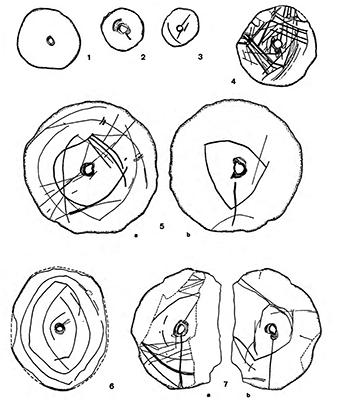
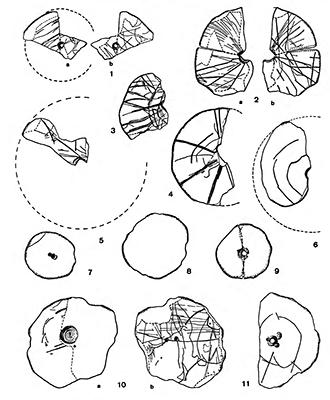
Rondelles in slate from Gönnersdorf Stadtkreis Neuwied.
Of the 302 rondelles which were either complete or could be substantially reconstructed with respect to size, the diameters varied between 20 mm and 90 mm, with a continuous transition between the individual measurements, there was no preferred size.
Photo and text: Bosinski (1977)
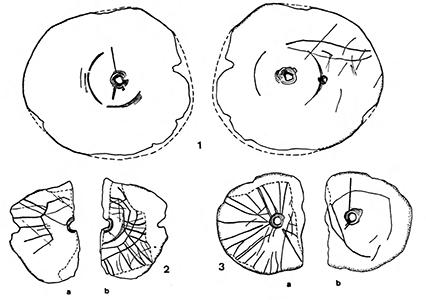
Rondelles in slate from Gönnersdorf Stadtkreis Neuwied.
Of the 302 rondelles, there were 29 discs, about 10%, less than 25 mm in diameter, and 53, 17.5%, with a diameter greater than 55 mm. The remaining 220 rondelles, 73%, had a diameter between 25 and 55 mm, and matched the sizes of those recovered from other sites.
Photo and text: Bosinski (1977)
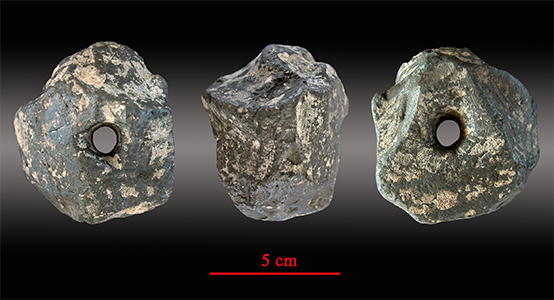
Rondelle, 5 cm diameter, pierced with a central hole the size of a pencil, from the Grotte des Enfants, Balzi Rossi (Italy), now kept in the Museum of Monaco.
It is made mostly of carbon mixed with organic matter.
Photo and text: http://precieux.mnhn.fr/?page_id=90
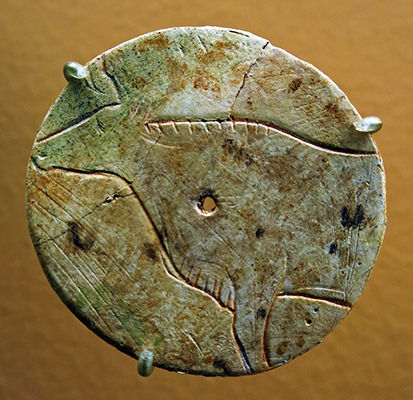
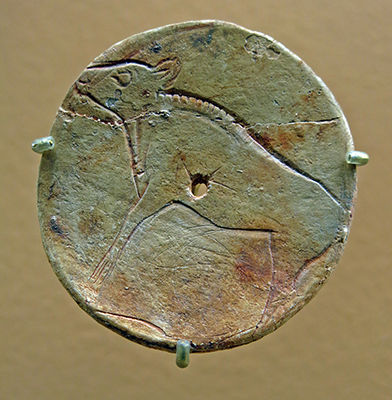
Engraving of an aurochs and a bison from Mas d'Azil.
The two sides are quite different. The one on the left depicts an adult aurochs considered a female because of the fine features of the head. The withers and chest are marked with small incisions. Horns and ears are sketched. The eye and the nostril are shown as points.
The other side of the disk shows a young bison, which, according to the size of the horn and the curvature of the hump might be about five months old. This young bison is half the size of the adult animal. Again, we find the same incisions along the shoulder and the chest. Aurochs females sometimes adopted baby bison.(I assume similar behaviour between cattle and bison has been recorded in zoos - Don )
(note also that the French Wikipedia wrongly credits the young bison rondelle as coming from Bédeilhac - Don )
Text: http://www.musee-archeologienationale.fr/template.php?SPAGE=2276
Photo: Don Hitchcock 2014
Source: Facsimile, Musée d'Archeologie Nationale et Domaine, St-Germain-en-Laye
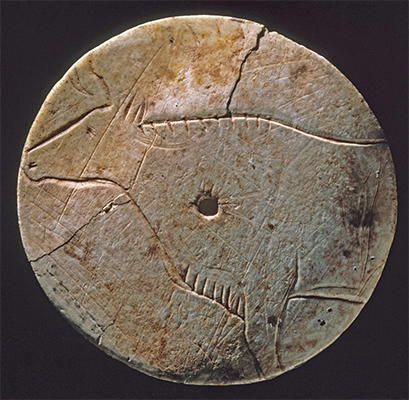

Disc discovered by Marthe and Saint-Just Péquart during excavations of the Magdalenian layers of the Mas d'Azil Cave.
This disc was cut from a scapula and engraved on both sides with figurative patterns. On one side is a female auroch, and on the other a young bison.
Length 51 mm, width 49 mm, thickness 1 mm. MAN 77 558
Photo:
© RMN-Grand Palais (musée d'Archéologie nationale) / Loïc Hamon
Source: http://www.sculpture.prehistoire.culture.fr/en/contenu/research.html#-multi-disciplinary-research

This scapula from Mas d'Azil was used as the base material for round disks similar to the ones above.
To the casual observer, it might seem that not much care was taken in making the discs completely round at the roughing out stage. However I have made my own rondelles from a sheep scapula, and even with modern tools it is by no means easy to get a completely circular disc.
Photo: Don Hitchcock 2014
Source: Facsimile, Musée d'Archeologie Nationale et Domaine, St-Germain-en-Laye

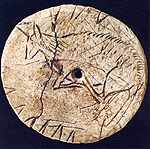
 Très mince rondelle en os, de 31 mm de diamètre, perforée en son
centre, avec sur chaque face la représentation d'un herbivore et des signes
en chevron le long des bords. Cette oeuvre d'art miniature fut découverte en
1868 par M. Hardy et publiée pour la première fois en 1872 dans "Le Magasin
pittoresque", revue populaire de l'époque.
Très mince rondelle en os, de 31 mm de diamètre, perforée en son
centre, avec sur chaque face la représentation d'un herbivore et des signes
en chevron le long des bords. Cette oeuvre d'art miniature fut découverte en
1868 par M. Hardy et publiée pour la première fois en 1872 dans "Le Magasin
pittoresque", revue populaire de l'époque.
Very thin disc in bone, 31 mm. in diameter, perforated in its centre, with on each face the representation of a herbivore (deer?) and chevrons along the edges. This miniature work of art was discovered in 1868 by M. Hardy and was published for the first time in 1872 in "Le Magasin pittoresque", a popular review of the time.
Photo and French text: Visiter les Abris de Laugerie-Basse - Alain Roussot - Editions Sud-Ouest.
My thanks to Anya for access to this resource.
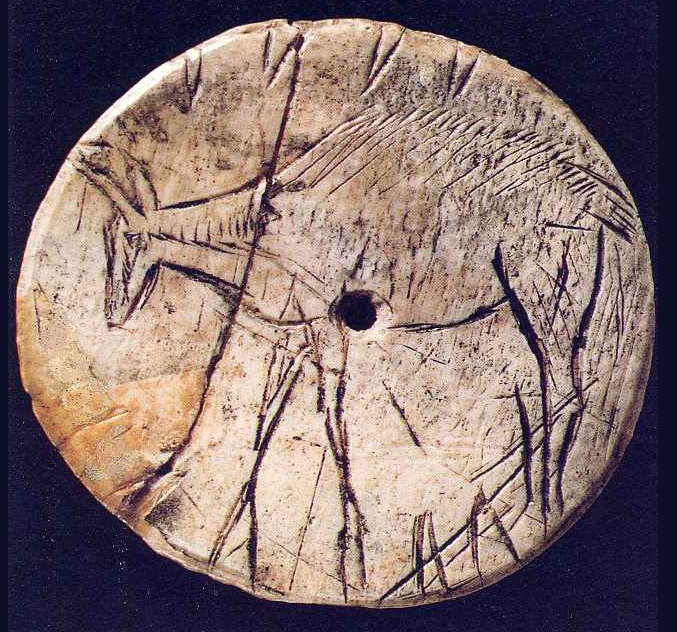
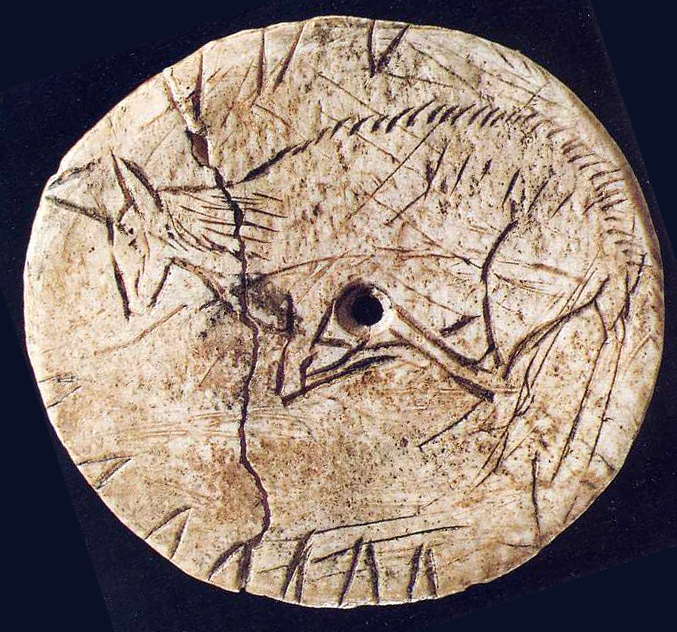
If it were to be used as a button, it would need a leather thong through the hole, knotted at the end. It would have been much more satisfactory for this purpose if it had had at least two holes.

Another view of the disc.
This looks like a museum quality facsimile.
Label:
Rondelle d'os gravée
Laugerie-Basse
Fouilles Hardy
Périgueux, Musée d’art et d’archéologie du Périgord
Pr.A. 1905
Photo: Don Hitchcock 2014
Source: Musée d’art et d’archéologie du Périgord, Périgueux
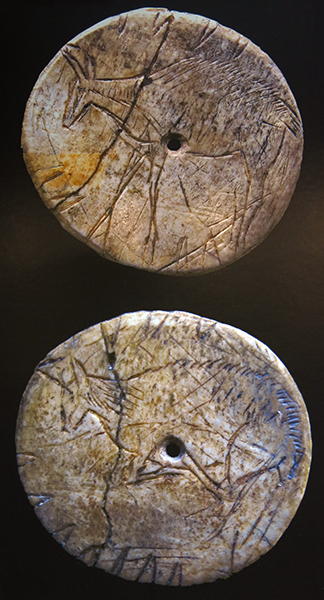
Poster showing the two sides of the disc.
Photo: Don Hitchcock 2014
Source: Musée d’art et d’archéologie du Périgord, Périgueux

Rondelle or disc cut out in a circular shape, with a hole through the centre. It is undecorated.
These discs are usually cut from a scapula (shoulder blade), which provides a ready made thin, flat support.
Photo: Don Hitchcock 2014
Source: Musée d’art et d’archéologie du Périgord, Périgueux
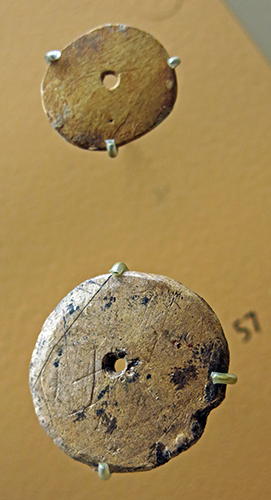
Rondelles (Mas d'Azil?)
Photo: Don Hitchcock 2014
Source: Facsimile, Musée d'Archeologie Nationale et Domaine, St-Germain-en-Laye

Rondelle with geometric ornamentation from Mas d'Azil.
Photo: Don Hitchcock 2014
Source: Facsimile, Musée d'Archeologie Nationale et Domaine, St-Germain-en-Laye

Multi perforated engraved disc from the Magdalenian discovered by Péquart at Mas d'Azil.
This disc cut from an omoplate or shoulder blade, has sixteen holes evenly spaced around the circumference with an extra one in the centre.
On each side of the disc, an engraved line connects the perforations. The disc is decorated with two bands of engraved hatching along the diameter of both sides of the central hole. Six pairs of convergent dashes in a chevron shape are within the bands of hatching.
This type of geometric pattern associated with multiple perforations can be found on several other pieces of discs found at the site.
Photo: http://www.arize.fr/Rondelle-multi-perforee.html
Text: translated and adapted from http://www.arize.fr/Rondelle-multi-perforee.html
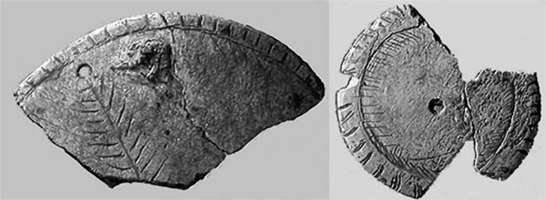
Engraved and perforated discs from Mas d'Azil.
(left) Disk with radiating barbed pattern.
(right) Disk with a central perforation, length 8cm.
Photo: Pleistocene Coalition News Vol 4, Issue 1, Jan-Feb 2012
Source: Saint-Germain en Laye Museum.

Man confronts a bear.
This is a stunning work from Mas d'Azil. It consisted originally of a disk, with an engraving on each side.
Disk carved from a scapula (bovine?) Fragmented, 78 mm x 37 mm.
On one side of the disk, we have a human male with an erect penis confronting a bear, with a heavy stick over his shoulder, and on the other side, a man being struck down by a bear. He appears to be shown lying face down, and uniquely, there is no other palaeolithic representation of a man in such a position. If the disc is tipped upside down on this face, a horse may be seen.
It was first described in Piette (1902)
Photo: Duhard (1992)
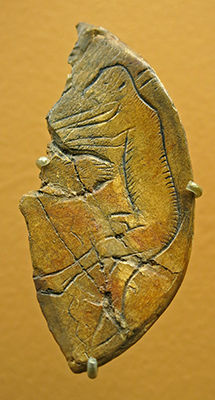
Rondelle découpée figurant un homme et une patte d'ours.
Disc showing a man and the paw of a bear.
Photo: Don Hitchcock 2014
Source: Facsimile, Musée d'Archeologie Nationale et Domaine, St-Germain-en-Laye
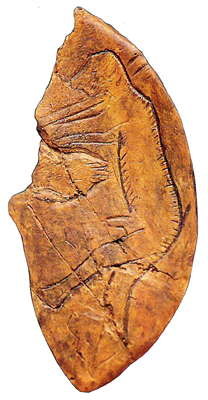
Another version of the man and bear.
Two representations of human figures, a horse, a bear and chevrons.
This exceptional piece is made of a scapula. This is the only representation of a composition combining the themes of bears and humans and a horse in a narrative sequence in the whole Palaeolithic corpus of art.
On the most famous face, the forelimb of the bear is directed toward the body of an upright man, looking to the left. Normally retracted, the bear's claws are out. The animal is on the offensive or defensive. The man is in a lively attitude. His left leg is lifted and his penis is erect, marking perhaps the effect of aggressive motivation, interpreted as a defensive reaction. HIs arms are stretched forward, and he carries on his right shoulder what appears to be a thick stick pointed at the animal. The theme of man being threatened by an animal is very rare throughout the Paleolithic iconographic furniture.
(cf the Lascaux bird man and disembowelled bison - Don )
On the reverse side, the scene seems to again be to the disadvantage of the human under threat by the same bear paw. The man was probably seen from the rear, and errors and omissions excepted, there is no other man seen from the rear in Paleolithic art.
If we tip the disc upside down on the reverse side, an engraving of the front of a horse, with a mane and high pronounced jaw appears.
Photo: http://www.arize.fr/Homme-au-bambou.html
Text: translated and adapted from http://www.arize.fr/Homme-au-bambou.html
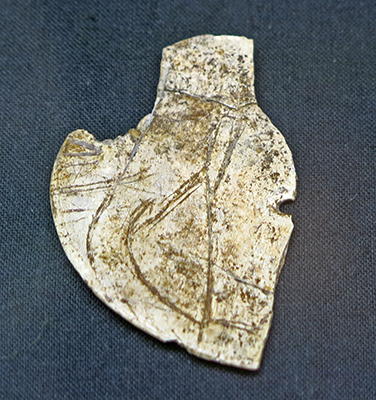
Fragment of a rondelle, a flat circular object always with a hole in the centre, as here. Often cut from a shoulder blade.
This one from l'abri de Raymonden, Chancelade, has a mammoth engraved, showing the trunk, one tusk, and another barely indicated, the mouth, the head, the eye, the shoulders and front leg.
Photo: Don Hitchcock 2014
Source: Original, Musée d’art et d’archéologie du Périgord, Périgueux
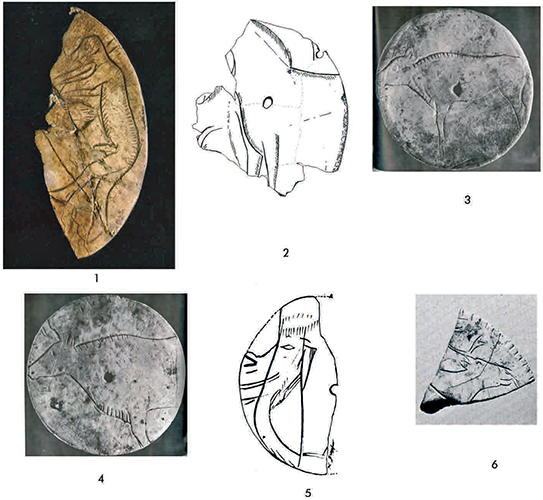
Rondelles from France with naturalistic decoration.
1. Mas d'Azil , Ariège, Chollot (1980)
2. La Tulière, Dordogne, Sieveking (1971)
3 and 4. Mas d'Azil Ariège, Barandiaráran (2006)
5. Raymonden , Dordogne (as in the colour photo above)
6. Mas d'Azil, Ariège, Chollot (1980)
Photo and text: De Las Heras et al. (2008)
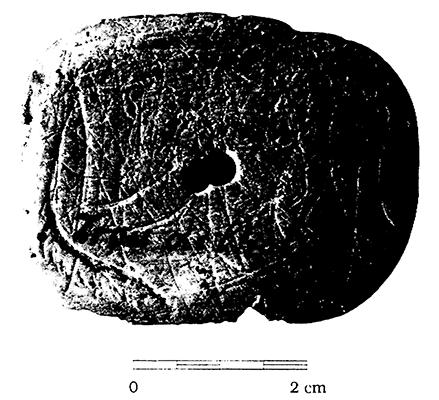
This rondelle or disc depicting a wooly mammoth was discovered in 1865 by E. Dupont.
It is made of ivory, and is subquadrangular in shape. The maximum width is 47.8 mm, the width of the larger perforations is 3.9 mm, and the maximum thickness is 3.4 mm.
Items close by the rondelle have been dated at 12 370 ± 170 BP, 12 990 ± 140 BP and 12 710 ± 150 BP.
Photo: P Cattelain
Source: Bott et al. (1994)
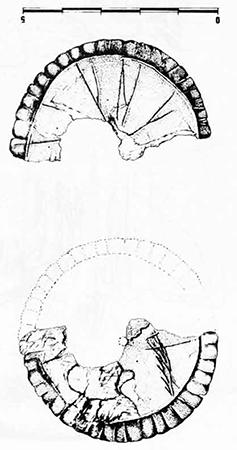
Rondelle from La Viña, Asturias.
(see colour photo below)
Photo: Fortea et al. (1987)

La Viña, boundary layer IV (lower):
Top row: horse cut out on a hyoid bone, engraved on both sides
Middle row: Deer rondelle and a contour cut on a rib.
Bottom layer: Llonín X, Rondelle engraved on both sides.
(note in particular with this lowest disc that the hole has not been made in the centre of the circular cutout of the scapula bone, but is eccentric - Don )
Photo and text: Rodríguez (2004)

Rondelle from Llonín, Asturias.
Photo: Fortea et al. (1990)

Rondelle découpée en os gravée (moulage)
Disc cut out and engraved, in bone.
Photo: Don Hitchcock 2014
Source: Facsimile, Musée d'Archeologie Nationale et Domaine, St-Germain-en-Laye
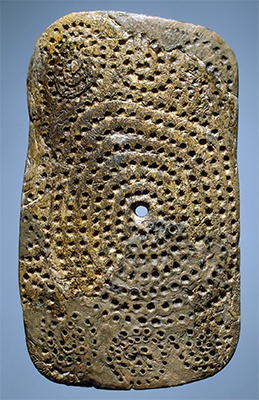
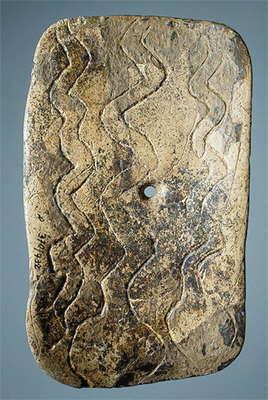
Plate with a hole in the centre.
Mammoth tusk; carved, polished and engraved. 138 x 81 mm.
Mal'ta Site (excavations by M.M. Gerasimov, 1928-1930), Siberia, the River Belaya, near Irkutsk, Russia
Maltinsko-buretskaya Culture. 23 000 - 19 000 BP
Photo and text: http://www.hermitagemuseum.org/

Left, face A of the rondelle from la grotte d'Enlène, showing an engraved bison.
Right, face B, a geometric design.
Photo: R. Bégouén
Source: Bégouén et al. (1989)
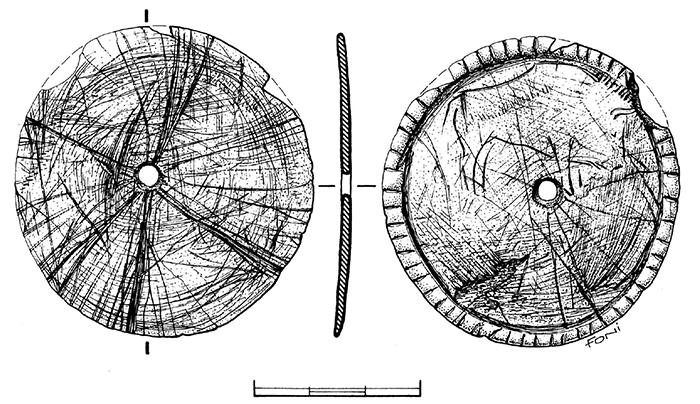
Left, face B of the rondelle from la grotte d'Enlène, showing a geometric design.
Right, face A, an engraved bison.
Drawing: F. Lebrun-Ricalens
Source: Bégouén et al. (1989)
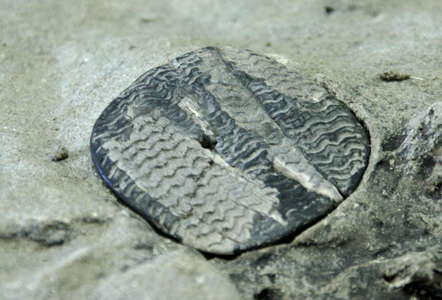
Plate, or rondelle. Found with the burial of a child. Mal'ta site.
(Note that this is a facsimile. It looks to me like the paler sections are replicas of the shards of the rondelle that were actually found, and the darker areas are the best guess for what the rest of the rondelle looked like - Don )
Photo: Vladimir Gorodnjanski 2007
Source: The Hermitage Museum, Saint Petersburg
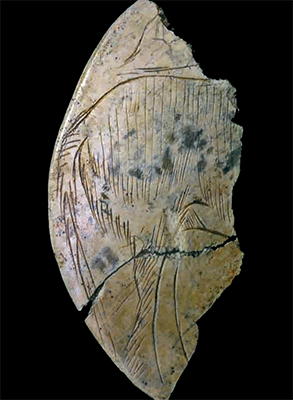
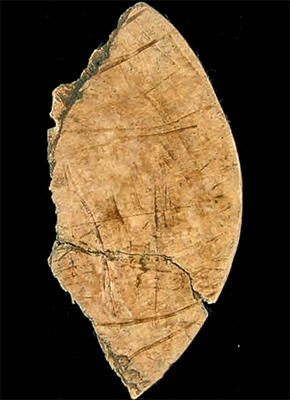
Rondelle from la Cueva de El Linar, sides A and B.
Photo: De Las Heras et al. (2008)
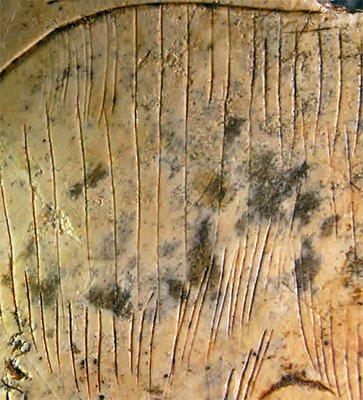
Close up of the engraving on the rondelle from la Cueva de El Linar.
Photo: De Las Heras et al. (2008)
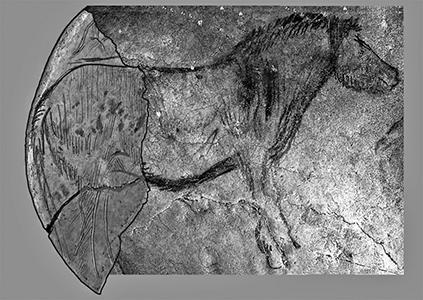
Rondelle from la Cueva de El Linar, showing that the image can be fitted perfectly to a cave wall painting from Niaux, indicating a wide ranging homogenous artistic tradition of painting and engraving across the Pyrenees from what is now France to Spain, and very close cultural links.
Photo: De Las Heras et al. (2008)

Rondelle découpée gravée de motifs géométriques
Disc cut out and engraved with geometric motifs, from la grotte de Saint-Michel-d'Arudy, Pyrénées-Atlantiques.
Photo: Don Hitchcock 2014
Source: Facsimile (?), Musée d'Archeologie Nationale et Domaine, St-Germain-en-Laye
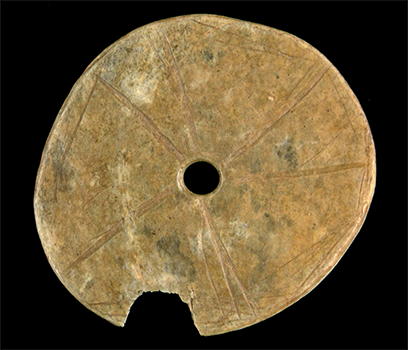
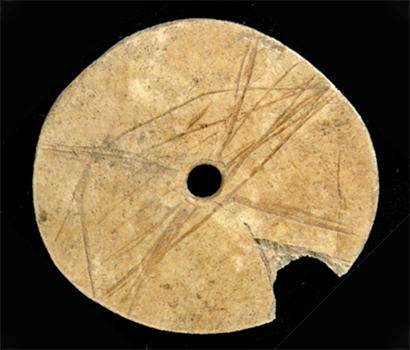
Rondelle from la Cueva de Las Aguas, sides A and B.
Photo: De Las Heras et al. (2008)

Rondelle from Gourdan, Haut-Garronne.
Photo: Chollot (1980)

Rondelle from la Cueva de Las Aguas, sides A and B and cross section.
Photo: De Las Heras et al. (2008)
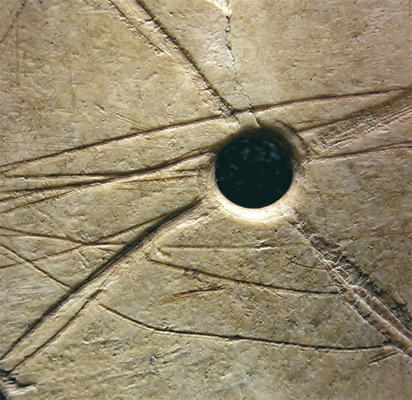
Close up of the centre of the rondelle from la Cueva de Las Aguas.
(note that I have rotated this image 180° so that the grooves look like grooves and not ridges. This illusion is because most people are used to seeing light come from the upper left when making sense of such an image, and is the convention used by map makers when showing relief by shadowing - Don )
Photo: De Las Heras et al. (2008)
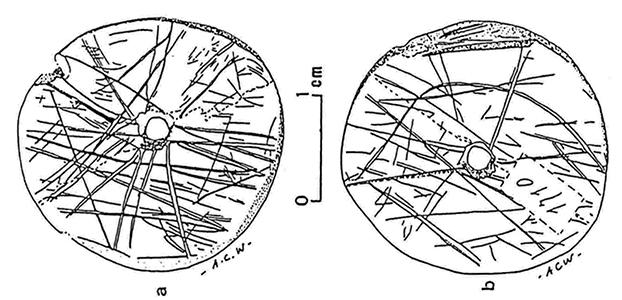
Rondelle from l'abri Plantade, Bruniquel, Tarn et Garonne.
Photo: Ladier et Welté (1993)
References
- Barandiaráran I., 2006: Imágenes y adornos en el arte portátil paleolítico, Col. Ariel Prehistoria, Barcelona.
- Bégouén R., Clottes J., Giraud J., Rouzaud F., 1989: La rondelle au bison d'Enlene (Montesquieuavantés, Ariège, Zephyrus, Revista de prehistoria y arqueología, ISSN 0514-7336, No. 41-42, 1988-1989, pp. 19-26
- Bosinski G., 1977: Die rondelle des Magdalénien-Fundplatzes Gönnersdorf, Quartär, 27/ 28. Bonn
- Bott S., Cattelain P., Jadin I., 1994: Un mammouth gravé sur une rondelle du Trou de Chaleux (Prov. de Namur), Notae Praehistoricae, 13, 1994
- Chollot M., 1980: Les origines du graphisme symbolique, Editions de la Fondation Singer-Poliganac, Paris
- De Las Heras C., Montes R., Lasheras J., Rasines P., Fatás P., 2008: Dos rodetes paleolíticos procedentes de las Cuevas del Linar y las Aguas, Alfoz de Lloredo (Cantabria), Veleia, 24-25, 2007-2008
- Fortea J., Corchón S., González Morales M., Rodríguez Asensio A., Hoyos M., Laville M., Fernandez Tresguerres J., 1987: Trabajos recientes en los valles del Nalón y del Sella, Colloque Internacional d’Art Mobilier Paléolithique, Foix, 1987, pp: 191 y ss.
- Fortea J., Rasilla Vives M., Rodrigues-Otero V., 1990: Sobre un rodete perforado magdaleniense de Llonín, Archivo de Prehistoria Levantina, vol XX, pp . 95 y ss., Valencia.
- Ladier, E., Welté C., 1993: Les objets de parure de la vallée de l'Aveyron, Fontales, Abris de Bruniquel (Plantade, Lafaye, Gandil), Paléo, N.5, 1993 pp. 281-317
- Rodríguez S., 2004: Palaeolithic Mobile Art in Cantabrian Spain and its prolongation in the Epipalaeolithic, Kobie,(Serie Anejos no. 8), año 2004. Las sociedades del Paleolítico en la región cantábrica.
- Sieveking A., 1971: A catalogue of Palaeolithic art in the British Museum, London
